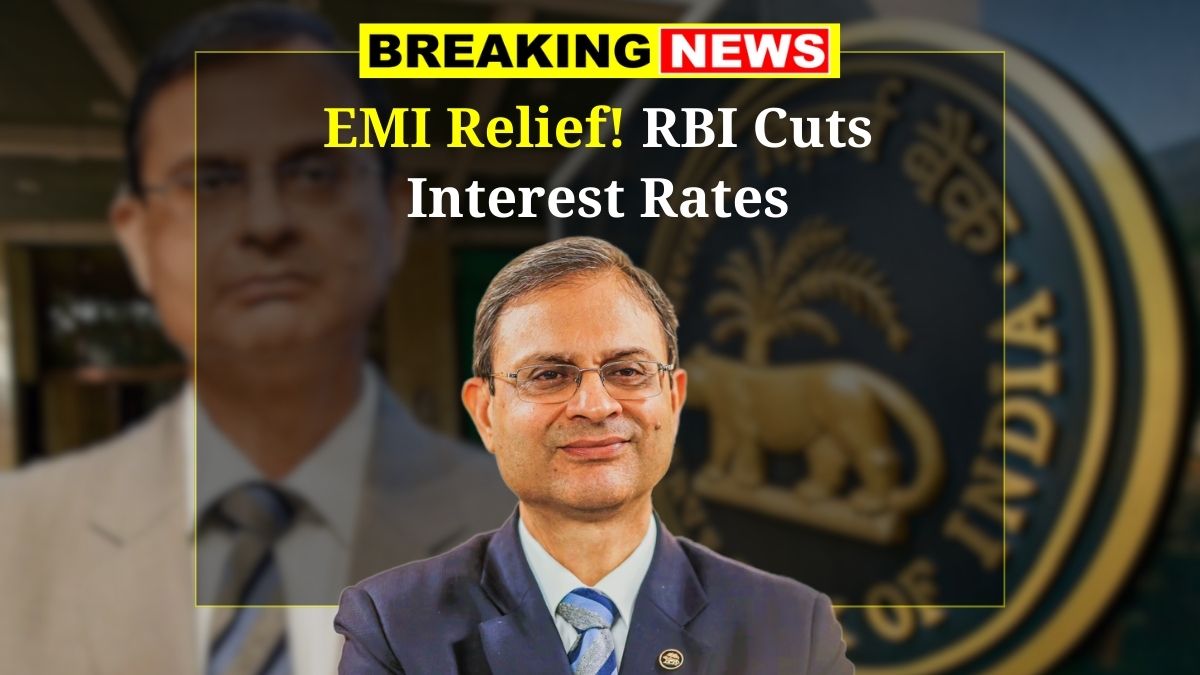RBI Repo Rate – In a recent announcement, the Reserve Bank of India (RBI) made a significant move that will benefit millions of borrowers across the country. The central bank has decided to reduce the repo rate, offering relief to individuals burdened by rising loan repayments. This change can have a positive impact on people paying off home loans, personal loans, or even education loans. Let’s break down what this rate cut means, how much you can save, and which sectors will benefit the most.
What Is the RBI Repo Rate Cut?
The repo rate is the rate at which the RBI lends money to commercial banks. When this rate is reduced, it becomes cheaper for banks to borrow money. In turn, banks can lower their lending rates to consumers, making loans more affordable. The RBI has reduced the repo rate by 0.25% (or 25 basis points), bringing it down from 6.25% to 6.00%. This change is expected to reduce the cost of borrowing for consumers.
What Does This Mean for You?
When the RBI cuts the repo rate, it signals that banks may lower their interest rates as well. This means you could see a decrease in your monthly loan repayments (EMIs). Here’s an idea of how much you might save across different types of loans:
- For a 20-year home loan of ₹20 lakh, your EMI might drop by around ₹444 per month, saving you ₹5,328 annually.
- On a ₹30 lakh loan with the same tenure, you could save ₹666 each month, adding up to ₹7,992 a year.
- For a ₹10 lakh personal loan over 15 years, the monthly savings could be ₹223, which means you’d save ₹2,676 over the year.
- For a smaller loan of ₹5 lakh over 10 years, expect savings of ₹96 per month or ₹1,152 annually.
- If you have a ₹25 lakh loan over 20 years, you could save ₹556 every month and ₹6,672 annually.
How Will Home Loan Borrowers Benefit?
For those with home loans, the rate cut is especially good news. Home loans typically have long repayment periods, and even a small reduction in the interest rate can result in considerable savings over time. Lower EMIs can make monthly payments more manageable, and it could also reduce the total amount of interest you end up paying over the life of the loan.
Personal and Auto Loans: What’s the Impact?
The benefits extend beyond home loans. Personal loan and car loan borrowers will also see some positive changes. Personal loans and car loans generally come with higher interest rates and shorter repayment periods, so any reduction in rates directly impacts how much you’ll pay each month. This could make car purchases more affordable and reduce the overall financial burden of personal loans.
What Are Banks Doing?
Many banks have already indicated that they plan to reduce their lending rates in the coming weeks. Some may even offer special interest rates to attract new customers, particularly during the festive season. Banks such as the State Bank of India (SBI), HDFC Bank, ICICI Bank, Axis Bank, and Kotak Mahindra Bank are likely to pass on the rate cuts to their borrowers, so keep an eye on your bank’s announcements to see when the new rates come into effect.
Which Sectors Will Gain the Most?
The RBI’s decision is not just a win for individual borrowers; it’s also expected to positively affect several key sectors of the economy. Here are some industries that stand to benefit:
- Real Estate: With cheaper home loans, buying a house becomes more affordable. This could lead to an uptick in property sales and construction.
- Automobile Industry: Lower car loan interest rates will make it easier for people to buy vehicles, potentially boosting sales in the auto sector.
- Retail: Easier access to credit could increase consumer spending, benefiting the retail industry.
- Education: Students and parents will likely see lower interest rates on education loans, making higher education more accessible.
- MSMEs: Small and medium enterprises will have easier access to working capital, potentially stimulating growth in this important sector.
Why Did the RBI Make This Move?
The RBI’s decision is driven by a desire to support economic growth in a global environment that remains uncertain. With inflation under control and the economy showing signs of moderate growth, the central bank is using the rate cut to stimulate demand and make credit more accessible to businesses and consumers alike.
In the RBI’s own words, the rate cut is intended to “nurture growth while ensuring that inflation remains within target levels.” It’s a strategy aimed at keeping the economy moving forward, especially in the face of global challenges.
What Should You Do if You Have a Loan?
If you already have a loan, here’s what you should do:
- Check Your Loan Terms: Find out if your loan is linked to the repo rate or another benchmark. Many loans are connected to these rates, so your bank may automatically reduce your EMI.
- Talk to Your Bank: Reach out to your lender to confirm if they will adjust your interest rate in line with the RBI’s decision.
- Consider Refinancing: If your bank doesn’t automatically adjust your rate, or if you think you can get a better deal elsewhere, refinancing might be an option.
What If You’re Planning to Take a Loan?
If you’re thinking about taking out a loan, now might be the best time to do so. Here’s why:
- Compare Rates: Shop around and compare interest rates across different banks to find the best deal.
- Lock in Lower Rates: Rates are expected to stay low for a while, so locking in a low rate now could save you money in the long term.
- Consider Fixed vs. Floating Rates: Evaluate whether a fixed-rate loan or a floating-rate loan is more suitable for your situation, depending on market conditions.
In conclusion, the RBI’s recent repo rate cut is great news for borrowers, offering an opportunity to reduce EMIs and overall borrowing costs. Whether you already have a loan or are planning to take one, it’s worth checking how this rate cut can benefit you. Keep an eye on your bank’s updates and act quickly to take advantage of this favorable financial environment.




